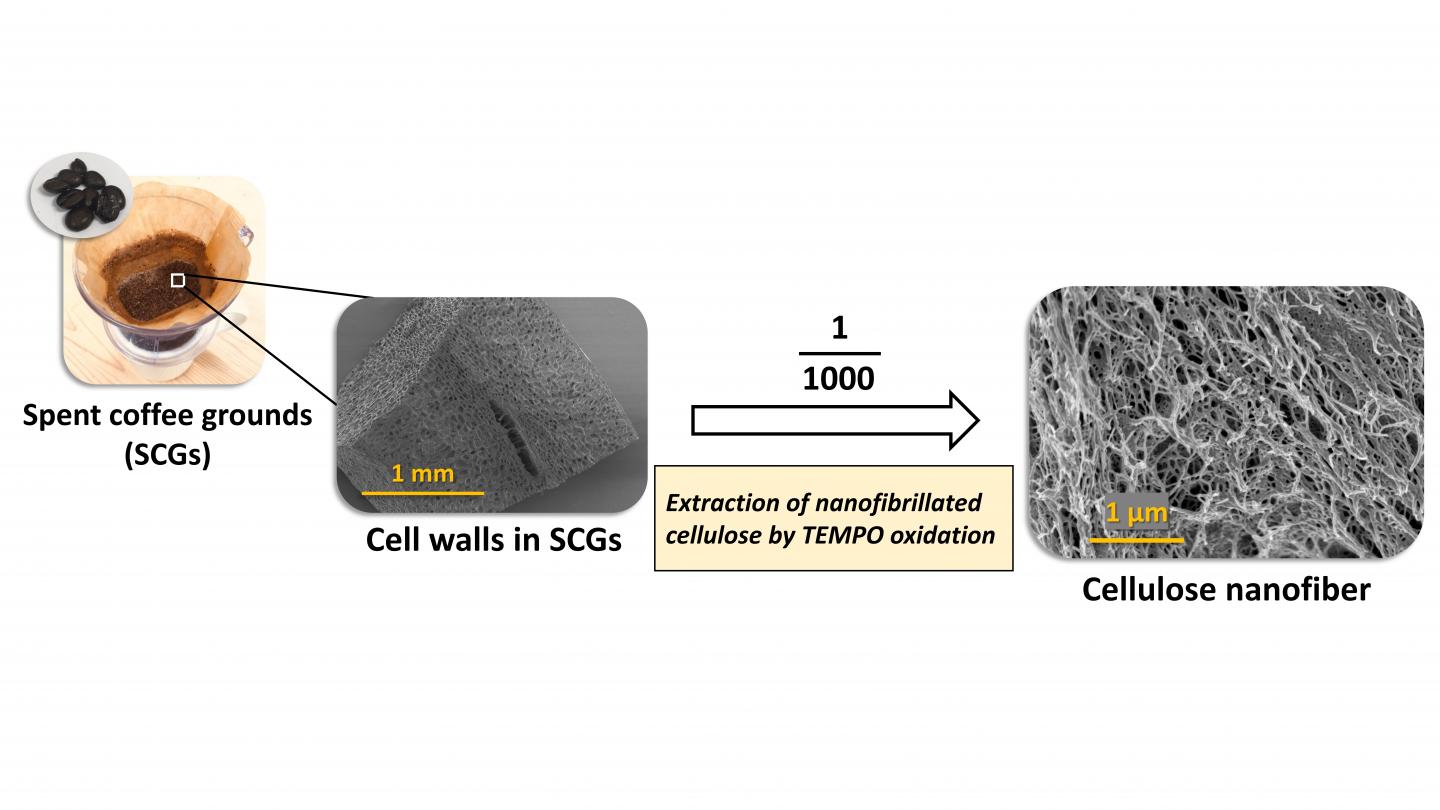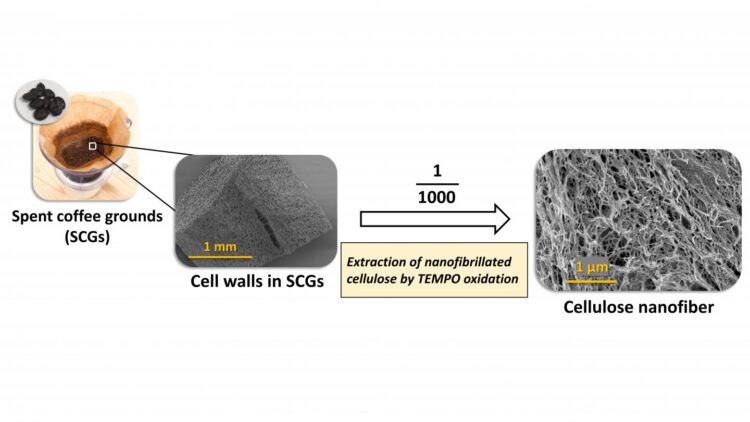
Credit: Yokohama National University
Researchers at Yokohama National University (YNU) meticulously examined cellulose nanofibers extracted from spent coffee grounds, identifying them as a viable new raw source.
The world generates over six million tons of coffee grounds, according to the International Coffee Organization. The journal Agriculture and Food Chemistry reported in 2012 that over half of spent coffee grounds end up in landfills. Cellulose nanofibers are the building blocks for plastic resins that can be made into biodegradable plastic products.
The YNU team, led by Izuru Kawamura, an associate professor at the Graduate School of Engineering Science, set out to build upon previous research into extracting cellulose nanofibers from coffee grounds. They published their findings on April 1 in the journal Cellulose.
“Our ultimate goal is to establish a sustainable recycling system with our cellulose nanofibers in the coffee industry,” Kawamura said. “Now, more and more restaurants and cafés have been banned from using single-use straws. Following that movement, we aim to make a transparent disposal coffee cup and straw with an additive comprising cellulose nanofibers from spent coffee grounds.”
Demand for cellulose nanofibers is increasing worldwide, as industries realize their potential as a more environmentally sound and sustainable way to produce plastics.
“Cellulose nanofibers have mainly been produced from wood-based materials such as pulp so far,” Kawamura said. “Cellulose nanofibers can be potentially supplied from all plants from nature. We would like to emphasize spent coffee grounds are a promising raw material.”
The key to extracting cellulose nanofibers from spent coffee grounds lies in cellulose, the material that comprises the beans’ cell walls and accounts for about half the weight and volume of the grounds.
The YNU team ran the experiment of isolating cellulose nanofibers from beans’ cell walls by catalytic oxidation, a process that oxidize the cell walls using a catalyst. This is a method previously reported by Akira Isogai at the University of Tokyo.
The team examined the resulting cellulose nanofibers with imaging techniques including x-ray diffraction, electron microscopy, and thermogravimetric analysis – a method of observing the fundamental structural features of cellulose nanofibers and comparing that derived from wood. The coffee ground-based cellulose nanofibers displayed uniformity and integrated well into polyvinyl alcohol, the building block for a variety of industrial and consumer products. His team found that their average diameter was 25 nanometers. For reference, a human hair measures about 90,000 nanometers in diameter.
Such consistency and integration with polymer resin are milestones that demonstrate the potential for coffee ground-based cellulose nanofibers as a wood substitute, Kawamura said, but further research is needed to develop a commercially viable process.
Kawamura believes cellulose nanofibers may soon play a major role in the automobile industry, offering a lightweight alternative to steel and plastic for auto bodies. As emission standards continue to tighten, the market for lighter cars will grow, making cellulose nanofibers an increasingly valuable commodity.
“The total weight of plastic resin made by cellulose nanofibers is very light compared to steel,” Kawamura said. “It will bring an efficient reduction of CO2 emission.” Resins built on nanofibers also work well in 3D printing, making them an environmentally friendly alternative to petroleum-based plastics for a host of potential products.
This new process may be a boon for the coffee industry, which has limited options for monetizing spent coffee grounds. Some cities have recycling programs, where spent coffee grounds are reused as nutrient-rich compost for greenhouses and mushroom farms. Other programs send spent coffee grounds to facilities that produce biogas. But overall, most coffee grounds still end up in landfills.
###
Yokohama National University (YNU or Yokokoku) is a Japanese national university founded in 1949. YNU provides students with a practical education utilizing the wide expertise of its faculty and facilitates engagement with the global community. YNU’s strength in the academic research of practical application sciences leads to high-impact publications and contributes to international scientific research and the global society. For more information, please see: https:/
Media Contact
Akiko Tsumura
[email protected]
Related Journal Article
http://dx.






